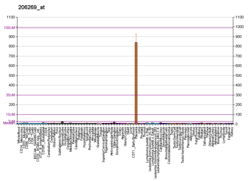GCM1
Chorion-specific transcription factor GCMa is a protein that, in humans, is encoded by the GCM1 gene.[5][6]
This gene encodes a DNA-binding protein with a gcm-motif (glial cell missing motif). The encoded protein is a homolog of the Drosophila glial cells missing gene (gcm). This protein binds to the GCM-motif (A/G)CCCGCAT, a novel sequence among known targets of DNA-binding proteins. The N-terminal DNA-binding domain confers the unique DNA-binding activity of this protein.[6]
References
- 1 2 3 GRCh38: Ensembl release 89: ENSG00000137270 - Ensembl, May 2017
- 1 2 3 GRCm38: Ensembl release 89: ENSMUSG00000023333 - Ensembl, May 2017
- ↑ "Human PubMed Reference:".
- ↑ "Mouse PubMed Reference:".
- ↑ Akiyama Y, Hosoya T, Poole AM, Hotta Y (Jan 1997). "The gcm-motif: a novel DNA-binding motif conserved in Drosophila and mammals". Proc Natl Acad Sci U S A. 93 (25): 14912–6. doi:10.1073/pnas.93.25.14912. PMC 26236. PMID 8962155.
- 1 2 "Entrez Gene: GCM1 glial cells missing homolog 1 (Drosophila)".
Further reading
- Yamada K, Ogawa H, Honda S, et al. (1999). "A GCM motif protein is involved in placenta-specific expression of human aromatase gene". J. Biol. Chem. 274 (45): 32279–86. doi:10.1074/jbc.274.45.32279. PMID 10542267.
- Nait-Oumesmar B, Copperman AB, Lazzarini RA (2000). "Placental expression and chromosomal localization of the human Gcm 1 gene". J. Histochem. Cytochem. 48 (7): 915–22. doi:10.1177/002215540004800704. PMID 10858268.
- Yamada K, Ogawa H, Tamiya G, et al. (2001). "Genomic organization, chromosomal localization, and the complete 22 kb DNA sequence of the human GCMa/GCM1, a placenta-specific transcription factor gene". Biochem. Biophys. Res. Commun. 278 (1): 134–9. doi:10.1006/bbrc.2000.3775. PMID 11071865.
- Yu C, Shen K, Lin M, et al. (2003). "GCMa regulates the syncytin-mediated trophoblastic fusion". J. Biol. Chem. 277 (51): 50062–8. doi:10.1074/jbc.M209316200. PMID 12397062.
- Strausberg RL, Feingold EA, Grouse LH, et al. (2003). "Generation and initial analysis of more than 15,000 full-length human and mouse cDNA sequences". Proc. Natl. Acad. Sci. U.S.A. 99 (26): 16899–903. doi:10.1073/pnas.242603899. PMC 139241. PMID 12477932.
- Mungall AJ, Palmer SA, Sims SK, et al. (2003). "The DNA sequence and analysis of human chromosome 6". Nature. 425 (6960): 805–11. doi:10.1038/nature02055. PMID 14574404.
- Chen CP, Chen CY, Yang YC, et al. (2005). "Decreased placental GCM1 (glial cells missing) gene expression in pre-eclampsia". Placenta. 25 (5): 413–21. doi:10.1016/j.placenta.2003.10.014. PMID 15081636.
- Baczyk D, Satkunaratnam A, Nait-Oumesmar B, et al. (2004). "Complex patterns of GCM1 mRNA and protein in villous and extravillous trophoblast cells of the human placenta". Placenta. 25 (6): 553–9. doi:10.1016/j.placenta.2003.12.004. PMID 15135239.
- Schubert SW, Kardash E, Khan MA, et al. (2005). "Interaction, cooperative promoter modulation, and renal colocalization of GCMa and Pitx2". J. Biol. Chem. 279 (48): 50358–65. doi:10.1074/jbc.M404587200. PMID 15385555.
- Gerhard DS, Wagner L, Feingold EA, et al. (2004). "The status, quality, and expansion of the NIH full-length cDNA project: the Mammalian Gene Collection (MGC)". Genome Res. 14 (10B): 2121–7. doi:10.1101/gr.2596504. PMC 528928. PMID 15489334.
- Yang CS, Yu C, Chuang HC, et al. (2005). "FBW2 targets GCMa to the ubiquitin-proteasome degradation system". J. Biol. Chem. 280 (11): 10083–90. doi:10.1074/jbc.M413986200. PMID 15640526.
- Knerr I, Schubert SW, Wich C, et al. (2005). "Stimulation of GCMa and syncytin via cAMP mediated PKA signaling in human trophoblastic cells under normoxic and hypoxic conditions". FEBS Lett. 579 (18): 3991–8. doi:10.1016/j.febslet.2005.06.029. PMID 16004993.
- Chang CW, Chuang HC, Yu C, et al. (2005). "Stimulation of GCMa transcriptional activity by cyclic AMP/protein kinase A signaling is attributed to CBP-mediated acetylation of GCMa". Mol. Cell. Biol. 25 (19): 8401–14. doi:10.1128/MCB.25.19.8401-8414.2005. PMC 1265739. PMID 16166624.
- Chuang HC, Chang CW, Chang GD, et al. (2006). "Histone deacetylase 3 binds to and regulates the GCMa transcription factor". Nucleic Acids Res. 34 (5): 1459–69. doi:10.1093/nar/gkl048. PMC 1401512. PMID 16528103.
- Fujito N, Samura O, Miharu N, et al. (2007). "Increased plasma mRNAs of placenta-specific 1 (PLAC1) and glial cells-missing 1 (GCM1) in mothers with pre-eclampsia". Hiroshima J. Med. Sci. 55 (1): 9–15. PMID 16594548.
- Chou CC, Chang C, Liu JH, et al. (2007). "Small ubiquitin-like modifier modification regulates the DNA binding activity of glial cell missing Drosophila homolog a.". J. Biol. Chem. 282 (37): 27239–49. doi:10.1074/jbc.M700351200. PMID 17646165.
This article is issued from
Wikipedia.
The text is licensed under Creative Commons - Attribution - Sharealike.
Additional terms may apply for the media files.






